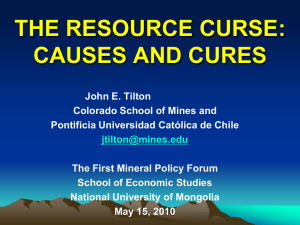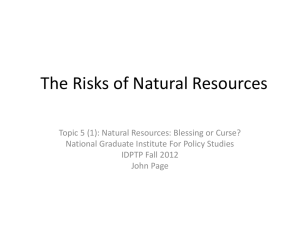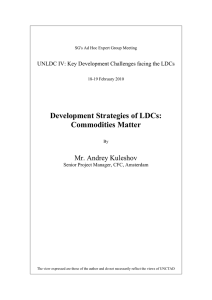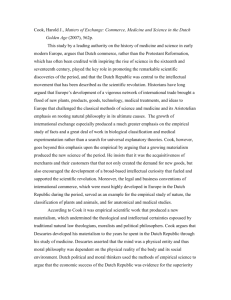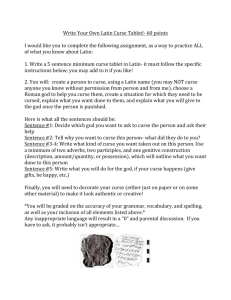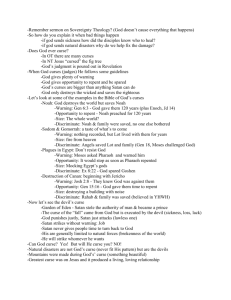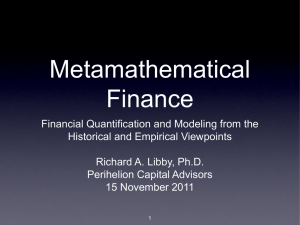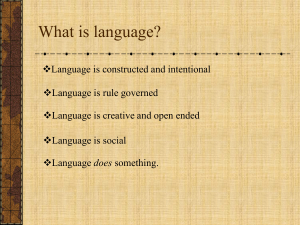Development Economics ECON 4915 Lecture 6
advertisement
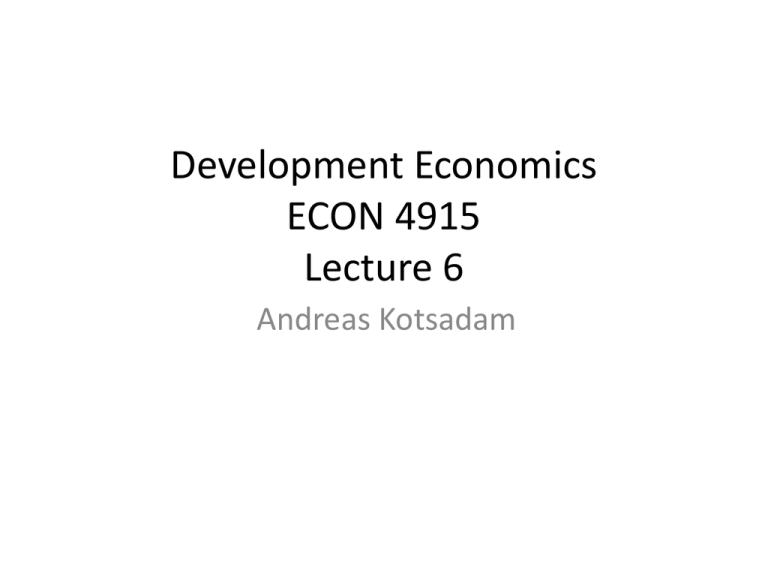
Development Economics ECON 4915 Lecture 6 Andreas Kotsadam Outline • Updated reading plan and some information. • Recap of empirical methods. • Possible exam question on insurance and recap from insurance lecture. • Natural resources. Updated lecture plan etc. • Notes from lecture 5 and seminar presentations are on the web. • New lecture plan: Lecture 8: Development and inequality GRY Ray Ch 7; Galor Lecture 9: Political and cultural change Beaman et al.; Jensen and Oster Recap of empirical methods. • Randomization requires minimal assumptions. • Non-experimental methods require assumptions that must be carefully assessed. • These assumptions cannot be proven so they must be very well argued. 4 Some important concepts. • • • • Identification strategy Reduced form Counterfactual Internal and external validity 5 Typical exam question • 4a) Describe ways in which insurance can affect permanent income (same as “How may risk lead to poverty traps and what is the role of insurance?)” (3 points). Typical exam question • 4b) If we have data on individuals in a village and we observe that the change in consumption perfectly follows the change in village income and is completely unrelated to changes in income at the household level. Is this evidence of perfect insurance? (3 points) Natural resources • Overview (Frankel) • Institutions (Mehlum et al) Frankel (2010) • Survey paper. • Considers the arguments for and against the curse and goes through six specific mechanisms. • Offers policy responses and an analysis of existing policies. Exports of primary products and growth Some econometric issues • Some studies find a negative, and some even a positive correlation. • Why? Control for different things. Different time periods, in particular in relation to discovery. Measurement issues: Endogeneity of exports. And also of natural endowments. Six aspects of commodity wealth • • • • • • Long-term price trends Volatility Crowding out of manufacturing Civil war Poor institutions Dutch disease Long-term price trends in commodity markets • Basically a “small open economy” argument. • But theoretically the trend can be upward or downward… • …and empirical evidence suggest that there is no long-term negative trend in world prices. Volatility • Low demand and supply elasticities in the short run. • Why would volatility be harmful? Risk aversion. Difficult to plan and invest. Crowding out of manufacturing • What happened to the comparative advantage hypothesis? • A counter argument is that industrial production entails more learning by doing than primary goods production. • Frankel is sceptical. • But see e.g. Ross (2008). ”Oil, Islam, and Women”. Resources and (civil) war • High incentives to fight over control for the resources. • Many studies find a correlation between conflict and resources. • But not everyone agrees. The effect of resources on institutions • Proposed mechanisms: Internal struggle for ownership. Inequality. Corruption. • But are natural resources really exogenous to institutions? The Dutch disease • When upward swings in world prices cause: Real appreciation in the currency. Increased government spending. Increased relative price of nontraded goods. Policy solutions • Reduce the impacts of volatility. • Spread risks. • Fiscal policy to make savings (as opposed to spending) procyclical. • Imposition of external checks and balances. Mehlum, Moene, and Torvik 2006 • The basic argument is that institutional differences determines whether natural resource abundance is a blessing or a curse. • “Imagine that a valuable natural resource is suddenly discovered both in Afghanistan and Switzerland. What would the economic consequences in each of the two countries be? Would the new wealth turn out to be a curse or a blessing?” Three perspectives on the role of institutions in the link between growth and natural resources • Resources harm institutions, and therefore growth. • There is no link, resources are bad for growth via the Dutch disease. • Resources interact with institutions. Theory • Two types of institutions: Grabber friendly: Rent-seeking and production are substitutes. Producer friendly: Rent-seeking and production are complements. • Rent-seeking: attempts to obtain economic rents by manipulating environment in which economic activities occur, rather than by creating new wealth. Assumptions behind the model • Producers and rent-grabbers stem from the same limited pool of entrepreneurs; • The entrepreneurs allocate themselves between production and grabbing until the return in both alternatives are equal; • Grabbers fight for natural resource rents and feed on the producers, implying that the return to grabbers depends negatively on their number; • In production there are joint economies implying that the return to producers depends positively on their number. Findings • Their key empirical result is that the resource curse is weaker the higher the institutional quality:
